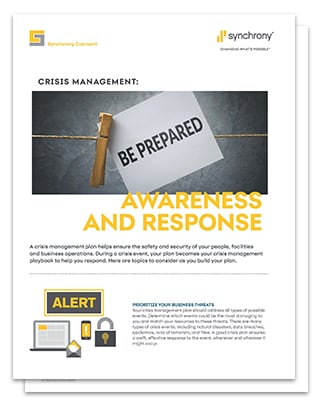A crisis management plan helps ensure the safety and security of your people, facilities and business operations. During a crisis event, your plan becomes your crisis management playbook to help you respond. Here are topics to consider as you build your plan.
PRIORITIZE YOUR BUSINESS THREATS
Your crisis management plan should address all types of possible events. Determine which events could be the most damaging to you and match your resources to these threats. There are many types of crisis events, including novel viruses, natural disasters, data breaches, epidemics/pandemics, acts of terrorism and fires. A good crisis plan ensures a swift, effective response to the event, whenever and wherever it might occur.
PUT DETAILS INTO YOUR CRISIS MANAGEMENT PLAN
Companies approach crisis management in different ways. Here is how you could organize your plan:
- Plan activation: Clarify when the plan should be implemented.
- Roles and responsibilities: Identify hazards, and the actions and responsibilities of team members.
- Response procedures: Prepare for what you can control and understand what you can’t control.
- Appendices: Report templates, employee contact information, benchmarking and sharing.
CREATE AN EVACUATION PLAN
All employees, including associates and managers, should know how to exit the building and where they should meet up once outside. In the case of tornados or other storm events, employees need to know where to find safe shelter.
PROVIDE CLEAR COMMUNICATIONS
Communicate during and after the event with your employees affected by a crisis event. Make sure you have current contact information available for all your employees. You could communicate via many channels: phone, email, text, Facebook Messenger, mail, etc. Clearly state what employees should be doing and not doing, based on the situation. As a best practice, only designated people within your company should interact with the media. Find out more about how to lead during a crisis.
PREPARE FOR WHAT COMES NEXT
In the case of a financial loss, utilize your partners, such as your insurance company and your financial and legal advisors. There are also resources for information on small business grants and loans. A leading resource is the Small Business Administration (SBA). You can find information at https://www.sba.gov/.


Download these tips now so you can be prepared for what’s next.
Download NowInterested in learning more about becoming a Synchrony partner?
- Fill out the
form below. - Our team will contact you within one business day.
- Together we’ll create a plan for your success.
Ready to level up your business? Get started today.
To learn more about enrolling your business to offer financing with Synchrony, call us toll-free at 1-844-866-8014.
Already enrolled with Synchrony? Sign in to Business Center or call 1-800-333-1082
Not a business owner? Call Consumer Help Desk at 1-866-893-7864.

Nice to meet you, .
One of our consumer financing specialists will be in touch soon to learn more about your business —and show you how Synchrony can help you grow it.
In the meantime, we invite you to browse the latest news, industry-specific perspectives and research on purchasing trends.
BUSINESS INSIGHTSThere seems to have been a problem submitting your information.
If this problem persists, please contact us.
Synchrony has over 80 years of retail heritage. Synchrony Connect is a value-added program that lets Synchrony partners tap into our expertise in areas beyond credit. It offers knowledge and tools that can help you grow, lead and operate your business. This content is subject to change without notice and offered for informational use only. You are urged to consult with your individual business, financial, legal, tax and/or other advisors with respect to any information presented. Synchrony and any of its affiliates (collectively, “Synchrony”) makes no representations or warranties regarding this content and accept no liability for any loss or harm arising from the use of the information provided. Your receipt of this material constitutes your acceptance of these terms and conditions.

